The AMD Ryzen 7 5700G, Ryzen 5 5600G, and Ryzen 3 5300G Review
by Dr. Ian Cutress on August 4, 2021 1:45 PM ESTCPU Tests: Legacy and Web
In order to gather data to compare with older benchmarks, we are still keeping a number of tests under our ‘legacy’ section. This includes all the former major versions of CineBench (R15, R11.5, R10) as well as x264 HD 3.0 and the first very naïve version of 3DPM v2.1. We won’t be transferring the data over from the old testing into Bench, otherwise it would be populated with 200 CPUs with only one data point, so it will fill up as we test more CPUs like the others.
The other section here is our web tests.
Web Tests: Kraken, Octane, and Speedometer
Benchmarking using web tools is always a bit difficult. Browsers change almost daily, and the way the web is used changes even quicker. While there is some scope for advanced computational based benchmarks, most users care about responsiveness, which requires a strong back-end to work quickly to provide on the front-end. The benchmarks we chose for our web tests are essentially industry standards – at least once upon a time.
It should be noted that for each test, the browser is closed and re-opened a new with a fresh cache. We use a fixed Chromium version for our tests with the update capabilities removed to ensure consistency.
Mozilla Kraken 1.1
Kraken is a 2010 benchmark from Mozilla and does a series of JavaScript tests. These tests are a little more involved than previous tests, looking at artificial intelligence, audio manipulation, image manipulation, json parsing, and cryptographic functions. The benchmark starts with an initial download of data for the audio and imaging, and then runs through 10 times giving a timed result.
We loop through the 10-run test four times (so that’s a total of 40 runs), and average the four end-results. The result is given as time to complete the test, and we’re reaching a slow asymptotic limit with regards the highest IPC processors.

Sizeable single thread improvements.
Google Octane 2.0
Our second test is also JavaScript based, but uses a lot more variation of newer JS techniques, such as object-oriented programming, kernel simulation, object creation/destruction, garbage collection, array manipulations, compiler latency and code execution.
Octane was developed after the discontinuation of other tests, with the goal of being more web-like than previous tests. It has been a popular benchmark, making it an obvious target for optimizations in the JavaScript engines. Ultimately it was retired in early 2017 due to this, although it is still widely used as a tool to determine general CPU performance in a number of web tasks.
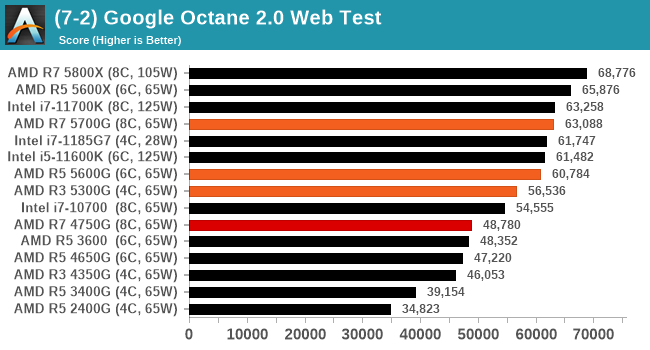
Speedometer 2: JavaScript Frameworks
Our newest web test is Speedometer 2, which is a test over a series of JavaScript frameworks to do three simple things: built a list, enable each item in the list, and remove the list. All the frameworks implement the same visual cues, but obviously apply them from different coding angles.
Our test goes through the list of frameworks, and produces a final score indicative of ‘rpm’, one of the benchmarks internal metrics.
We repeat over the benchmark for a dozen loops, taking the average of the last five.
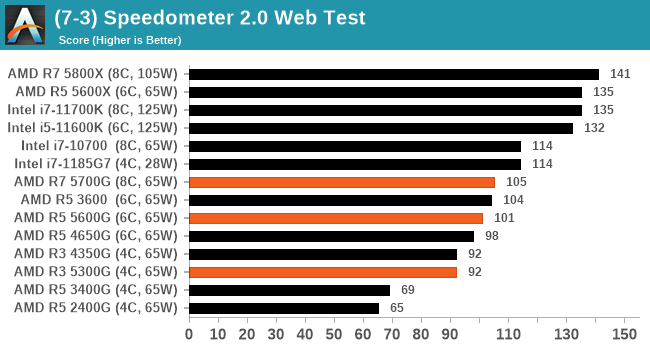
Legacy Tests
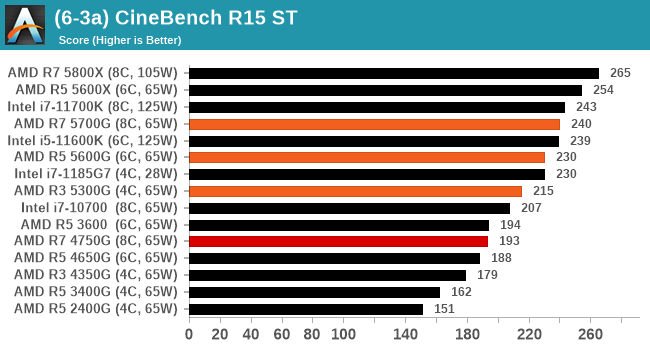
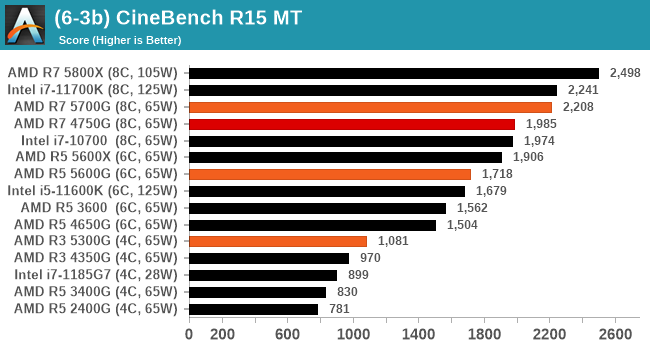
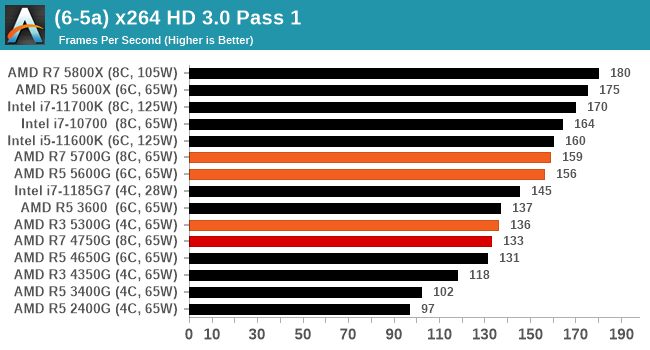
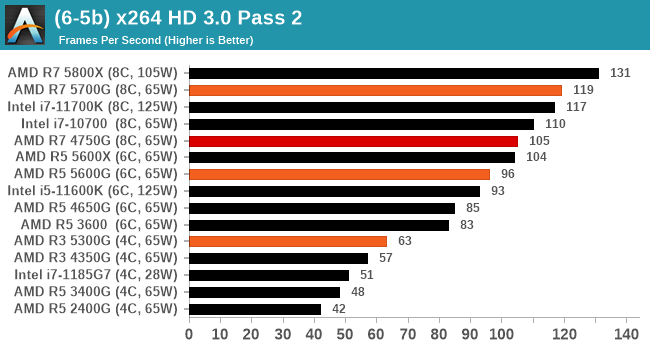

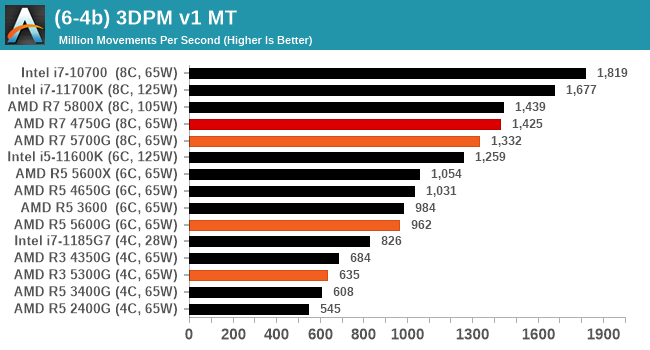


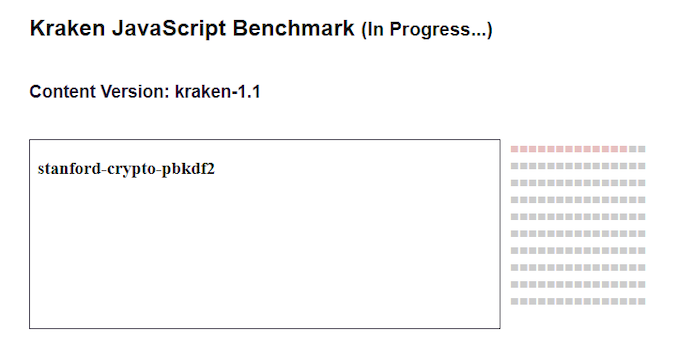
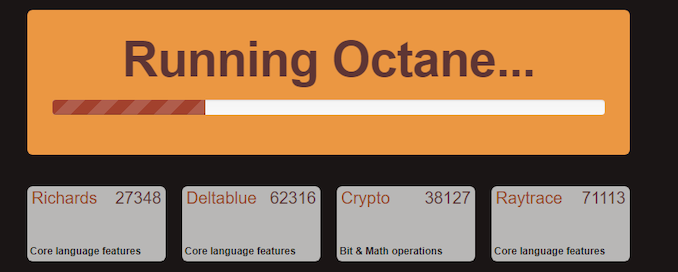
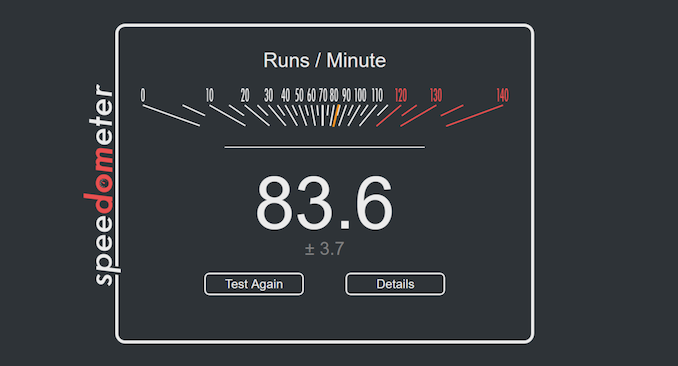








135 Comments
View All Comments
Wereweeb - Wednesday, August 4, 2021 - link
The bottleneck is memory bandwidth. DDR5 will raise the iGPU performance roof by a substantial amount, but I hope for something like quad-channel OMI-esque Serial RAM.abufrejoval - Saturday, August 7, 2021 - link
I'd say so, too, but...I have just had a look at a Kaveri A10-7850K with DDR3-2400 (100 Watt desktop), a 5800U based notebook with LPDDR4 (1333MHz clock) and a Tiger Lake NUC with an i7-1165G7 with DDR4-3200.
The memory bandwidth differences between the Kaveri and the 5800U is absolutely minor, 38.4 GB/s for the Kaveri vs. 42.7GB/s for Cezanne (can't get the TigerLake figures right now, because it's running a Linux server, but it will be very similar).
The Kaveri and Cezanne iGPUs are both 512 shaders and apart from architectural improvements very much differ in clocks 720MHz vs. 2000MHz. The graphics performance difference on things like 3DMark scale pretty exactly with that clock difference.
Yet when Kaveri was launched, Anandtech noted that the 512 shader A10 variant had trouble to do better then the 384 shader APUs, because only with the very fastest RAM it could make these extra shaders pump out extra FPS.
When I compared the Cezanne iGPU against the TigerLake X2, both systems at tightly fixed 15 and 28Watts max power settings, TigerLake was around 50% faster on all synthetic GPU benchmarks.
The only explanation I have for these fantastic performance increases is much larger caches being very smartly used by breaking down GPU workloads to just fit within them, while prefetching the next tile of bitmaps into the cache in the background and likewise pushing processed tiles to the framebuffer RAM asynchronously to avoid stalling GPU pipelines.
And yet I'd agree that there really isn't much wiggling room left, you need exponential bandwidth to cover square resolution increases.
abufrejoval - Saturday, August 7, 2021 - link
need edit!Is TigerLake Xe, not X2.
Another data point:
I also have an NUC8 with an 48EU (+128MB eDRAM) Iris 655 i7 and a NUC10 with an 24EU "no Iris" UHD i7. Even with twice the EUs and the extra eDRAM (which I believe can be used in parallel to the external DRAM), the Iris only gets a 50% performance increase.
The the 96EU TigerLake iGPU is doing so much better (better than linear scale over UHD) while it actually has somewhat less bandwidth (and higher latency) than the 50GB/s eDRAM provides for the 48EU Iris.
bwj - Wednesday, August 4, 2021 - link
Why are these parts getting stomped by Intel and their non-graphics Ryzen siblings?bwj - Wednesday, August 4, 2021 - link
Meh, meant to say "in browser benchmarks". Browser is an important workload (for me at least) and the x86 crowd is already fairly weak versus Apple M1, so I'm not ready to throw away another 30% of browser perf.Lezmaka - Wednesday, August 4, 2021 - link
There are only 3 browser tests and for two of them the 5700G is within a few percent of the 11700K. But otherwise, it's because these are laptop chips with higher TDP. The 11700K has a TDP of "125W" but hit 277W where the 5700G has a TDP of 65W and maxed out at 88W.Makaveli - Wednesday, August 4, 2021 - link
There is something up with the browser scores here anyways compared to what you see in the forum. All the post with similar desktop cpu's in that thread post much high scores than what is listed in the graph. I'm not sure its old browser version being used to keep scores inline with older reviews or something.https://forums.anandtech.com/threads/how-fast-is-y...
abufrejoval - Wednesday, August 4, 2021 - link
When you ask: "Why don't they release the four core variant?" you really should be able to answer that yourself!There are simply not enough defective chips to make it viable just yet. Eventually they may accumulate, but as long as they are trying to produce an 8 core chip, 4 and 6 cores should remain the exception not the rule.
I'd really like to see them struggle putting the lesser chips out there, because it means my 8/16(/32/64) core chips are rock solid!
I would have liked to see full transistor counts of the 5800X and the 5700U side by side. My guess would be that the Cezanne dies even at 50% cache have more transistors overall, meaning you are getting many more pricey 7nm transistors per € on these APUs and should really pay a markup not a discount.
Well even the GF IO die fab capacity might have customers lined up these days, but in normal times those transistors should be much more commodity and cheaper and have the APU cost more in pure foundry (less in packaging) than the X-variants, while AMD wants to fit it into a below premium price slot where it really doesn't belong.
nandnandnand - Wednesday, August 4, 2021 - link
If AMD boosted chiplet/monolithic core count to 12, maybe 6 cores could become the new minimum with 10-core being a possibility. But it doesn't look like they plan to do that.Wereweeb - Wednesday, August 4, 2021 - link
These might have been a stockpile of dies that were rejected for laptop use (High power consumption @ idle?) and they're being dumped into the market after AMD satisfied OEM demand for APU's.Plus, considering that one of the main shortages is for substrates, it's possible that the substrate for the APU's is different - cheaper, higher volume, etc... as it doesn't need to interconnect discrete chiplets.